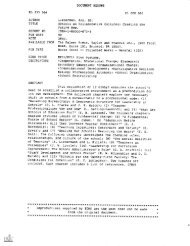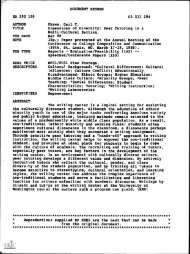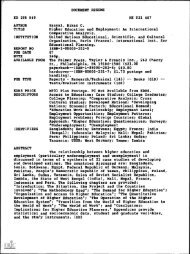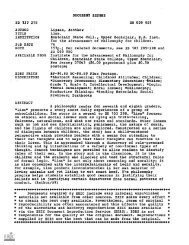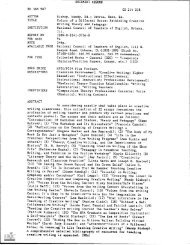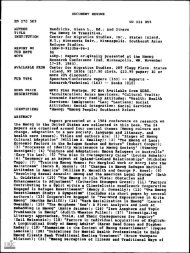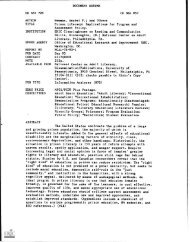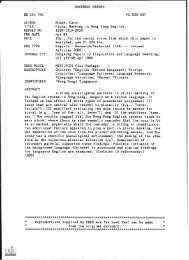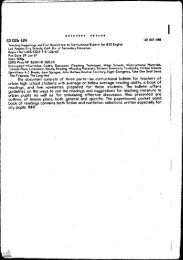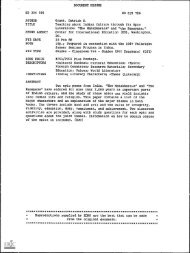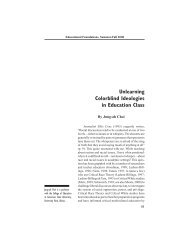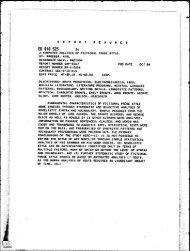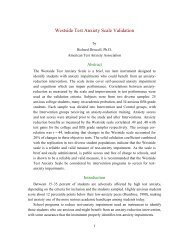Digital Storytelling: A Tool for Teaching and Learning in the ... - Eric
Digital Storytelling: A Tool for Teaching and Learning in the ... - Eric
Digital Storytelling: A Tool for Teaching and Learning in the ... - Eric
You also want an ePaper? Increase the reach of your titles
YUMPU automatically turns print PDFs into web optimized ePapers that Google loves.
NMSA Home l NMSA Store l Annual Conference l Month of <strong>the</strong> Young Adolescent l Contact NMSASite Search:Wednesday, July 27, 2011About NMSA l Advocacy l Membership l Professional Development l Professional Preparation l Publications l Research l NMSA StoreHome > Publications > Middle School Journal > Articles > May 2011 > Article 3Featured L<strong>in</strong>ksAccount Log<strong>in</strong>User Name:Middle School JournalMiddle GroundMay 2011 • Volume 42 • Number 5 • Pages 4-9Password:RMLE Onl<strong>in</strong>eToday's Middle LevelEducator<strong>Digital</strong> <strong>Storytell<strong>in</strong>g</strong>: A <strong>Tool</strong> <strong>for</strong> <strong>Teach<strong>in</strong>g</strong><strong>and</strong> <strong>Learn<strong>in</strong>g</strong> <strong>in</strong> <strong>the</strong> YouTube Generation*This We Believe CharacteristicsRemember Log<strong>in</strong>Middle E-ConnectionsClassroom ConnectionsThe Family ConnectionOn TargetWeb ExclusiveBook Publish<strong>in</strong>gGet ConnectedMiddle Level InsiderMonthly e-newsletterfeatur<strong>in</strong>g useful articles,education news, freeresources, book excerpts,videos, <strong>and</strong> more.The MarketplaceA showcase of products <strong>and</strong>services designed <strong>for</strong>schools <strong>and</strong> classrooms.Job ConnectionBrowse resumes or postemployment opportunities.RSS FeedsNMSA RSS feeds keep youup to date on middlegrades news <strong>and</strong> headl<strong>in</strong>es.Twitter@NMSAnewsYou can follow NMSA News<strong>and</strong> Headl<strong>in</strong>es @Twitter.Mean<strong>in</strong>gful <strong>Learn<strong>in</strong>g</strong>Challeng<strong>in</strong>g CurriculumMultiple <strong>Learn<strong>in</strong>g</strong> Approaches*Denotes <strong>the</strong> correspond<strong>in</strong>g characteristics from NMSA's position paper, ThisWe Believe, <strong>for</strong> this article.Oliver Dreon, Richard M. Kerper, & Jon L<strong>and</strong>isSay <strong>the</strong> phrase "Charlie bit my f<strong>in</strong>ger," <strong>and</strong> just about every humanbe<strong>in</strong>g with Internet access visualizes <strong>the</strong> viral video clip of baby Charlieprecociously bit<strong>in</strong>g <strong>the</strong> f<strong>in</strong>ger of his bro<strong>the</strong>r. With almost 200 millionviews, this video represents just one of thous<strong>and</strong>s of viral videos that<strong>for</strong>m a core component of modern enterta<strong>in</strong>ment, news, <strong>and</strong> advertis<strong>in</strong>g(Purcell, 2010). These snippets that people e-mail, post, <strong>and</strong> pass on toone ano<strong>the</strong>r faster than <strong>the</strong> common cold have rapidly moved from <strong>the</strong>fr<strong>in</strong>ge of youth culture to <strong>the</strong> ma<strong>in</strong>stream.What if teachers could capitalize on student <strong>in</strong>terest <strong>in</strong> <strong>the</strong>se quick <strong>and</strong>quirky video clips as a way to help students connect with curriculum?That is exactly what Tyler B<strong>in</strong>kley, a first-year teacher <strong>and</strong> member of<strong>the</strong> YouTube generation, has set out to do <strong>in</strong> his middle school mathclass. Tyler creates onl<strong>in</strong>e math video vignettes that teach critical mathskills (B<strong>in</strong>kley, 2010), <strong>and</strong> his unique approach has been featured ontelevision <strong>and</strong> <strong>in</strong> o<strong>the</strong>r news outlets (e.g., Miller, 2010). His studentsreport go<strong>in</strong>g to Tyler's YouTube channel whenever <strong>the</strong>y struggle with acurrent math task; <strong>and</strong> with thous<strong>and</strong>s of views, Tyler's videos are aviral hit <strong>in</strong> Palmyra (PA) Middle School.In this article, Oliver Dreon <strong>and</strong> Jon L<strong>and</strong>is, educational technologyprofessors, <strong>and</strong> Richard Kerper, a children's <strong>and</strong> young adolescentliterature professor, expla<strong>in</strong> <strong>the</strong> emergence of Tyler's use of digitalstorytell<strong>in</strong>g <strong>in</strong> his middle school classroom. The article outl<strong>in</strong>es how<strong>in</strong>structional technology <strong>and</strong> content-specific courses <strong>in</strong> <strong>the</strong> teachereducation program work <strong>in</strong> t<strong>and</strong>em to develop beg<strong>in</strong>n<strong>in</strong>g teachers'underst<strong>and</strong><strong>in</strong>g of digital storytell<strong>in</strong>g as an educational tool. Thiscoord<strong>in</strong>ation of ef<strong>for</strong>ts offers a framework <strong>for</strong> <strong>in</strong>corporat<strong>in</strong>g digitalstorytell<strong>in</strong>g <strong>in</strong> <strong>the</strong> middle grades classroom <strong>and</strong> can also help practic<strong>in</strong>gteachers underst<strong>and</strong> <strong>the</strong> educational importance <strong>and</strong> cultural value of<strong>the</strong> digital storytell<strong>in</strong>g medium.The importance of digital storytell<strong>in</strong>gView <strong>Digital</strong> IssuePreview/Purchase<strong>Digital</strong> IssueJo<strong>in</strong>/Renew NMSAto Receive thisMember BenefitJo<strong>in</strong>/Renew MembershipNMSA Account FAQsCreate an AccountForgot Password?Member Access CenterAbout NMSAWith more than 30,000members <strong>in</strong> 48 countries,NMSA is <strong>the</strong> voice <strong>for</strong>those committed to <strong>the</strong>educational <strong>and</strong>developmental needs ofyoung adolescents. More.Featured EventsNMSA2011—38th AnnualConference & ExhibitLouisville, KYNovember 10-12, 2011<strong>Digital</strong> BrochureNMSA on FacebookBecome a fan. Visit NMSA'sfan page on Facebook.Grow<strong>in</strong>g up with unprecedented access to technology has changed <strong>the</strong>way young people, "digital natives," communicate, <strong>in</strong>teract, process<strong>in</strong><strong>for</strong>mation, <strong>and</strong> learn (Obl<strong>in</strong>ger & Obl<strong>in</strong>ger, 2005; Prensky, 2001a,2001b). Thus, many new teachers enter<strong>in</strong>g 21st century classrooms aredigital natives teach<strong>in</strong>g digital natives (Prensky, 2001a). Lei's (2009)study of a group of digital native preservice teachers suggests that,although future teachers may hold strong positive beliefs abouttechnology <strong>and</strong> may be proficient with a variety of softwarePDF VersionCalendar of eventsFeatured Resources
applications, <strong>the</strong>y may be unable to translate this knowledge to <strong>the</strong>irteach<strong>in</strong>g. "<strong>Digital</strong> natives," Lei argued, "need to develop a systematicunderst<strong>and</strong><strong>in</strong>g of <strong>the</strong> technology, subject matter, pedagogy, <strong>and</strong> how<strong>the</strong>se aspects work toge<strong>the</strong>r" (p. 93).Tyler's YouTube math videos make evident that he has been able to<strong>in</strong>corporate technology effectively <strong>in</strong> his classroom (B<strong>in</strong>kley, 2010).While <strong>the</strong> videos are <strong>in</strong>structional <strong>in</strong> nature, each video also tells ahumorous story that <strong>in</strong>volves a host of characters <strong>and</strong> has a dist<strong>in</strong>ctplot. Although Tyler's onl<strong>in</strong>e videos focus on teach<strong>in</strong>g important mathconcepts, <strong>the</strong> stories are what ultimately engage his students.<strong>Digital</strong> storytell<strong>in</strong>g is <strong>the</strong> art of comb<strong>in</strong><strong>in</strong>g narrative with digital mediasuch as images, sound, <strong>and</strong> video to create a short story (Rob<strong>in</strong>, 2008).More than just a simple slideshow of photos set to music, digital stories<strong>in</strong>terweave different media to support <strong>the</strong> art of tell<strong>in</strong>g a tale. In <strong>the</strong><strong>Digital</strong> <strong>Storytell<strong>in</strong>g</strong> Cookbook, Lambert (2006) identifies seven elementsthat are critical components of effective digital stories (see Figure 1).While <strong>the</strong>se elements outl<strong>in</strong>e <strong>the</strong> nature of effective digital stories, <strong>the</strong>process of creat<strong>in</strong>g a digital story <strong>in</strong>volves leverag<strong>in</strong>g a wide variety ofskills, <strong>in</strong>clud<strong>in</strong>g research<strong>in</strong>g topics, writ<strong>in</strong>g scripts, storyboard<strong>in</strong>g, <strong>and</strong>assembl<strong>in</strong>g <strong>the</strong> f<strong>in</strong>al product us<strong>in</strong>g video edit<strong>in</strong>g software (Ohler, 2006).May 2011Mean<strong>in</strong>gful <strong>Learn<strong>in</strong>g</strong><strong>in</strong> 21st Century SchoolsThis We Believe:Keys to Educat<strong>in</strong>gYoung AdolescentsResearch & ResourcesIn Support ofThis We BelieveNMSA onl<strong>in</strong>e storeFigure 1The seven elements of digital storytell<strong>in</strong>g1. Po<strong>in</strong>t of view: Outl<strong>in</strong>es <strong>the</strong> po<strong>in</strong>t of <strong>the</strong> story <strong>and</strong> <strong>the</strong>perspective from which <strong>the</strong> story is told.2. A dramatic question: Sets <strong>the</strong> tension of <strong>the</strong> story byidentify<strong>in</strong>g issues to be resolved.3. Emotional content: Engages <strong>the</strong> audience through commonemotions <strong>and</strong> <strong>the</strong>mes (love, pa<strong>in</strong>, humor).4. The gift of your voice: Helps <strong>the</strong> audience make mean<strong>in</strong>g ofimages.5. The power of <strong>the</strong> soundtrack: Sets <strong>the</strong> mood of <strong>the</strong> story.6. Economy: Balances <strong>the</strong> auditory <strong>and</strong> visual tracks of mean<strong>in</strong>g.7. Pac<strong>in</strong>g: Susta<strong>in</strong>s <strong>the</strong> attention of <strong>the</strong> audience by establish<strong>in</strong>g<strong>and</strong> modify<strong>in</strong>g <strong>the</strong> rhythm of <strong>the</strong> story.Adapted from Lambert (2006)The medium of digital storytell<strong>in</strong>g offers tremendous opportunities <strong>for</strong>teachers to engage <strong>and</strong> assess students. By <strong>in</strong>tegrat<strong>in</strong>g visual imageswith written text, digital stories can be used to enhance <strong>and</strong> acceleratestudent comprehension (Burmark, 2004; Rob<strong>in</strong>, 2008). For example,when us<strong>in</strong>g digital storytell<strong>in</strong>g with middle <strong>and</strong> high school students,Kajder <strong>and</strong> Swenson (2004) found that digital stories helped struggl<strong>in</strong>greaders envision text <strong>and</strong> offered a plat<strong>for</strong>m <strong>for</strong> visually communicat<strong>in</strong>gmean<strong>in</strong>g. When creat<strong>in</strong>g <strong>the</strong>ir own digital stories, students encounter an<strong>in</strong>tegrated <strong>in</strong>structional activity that requires <strong>the</strong>m to leverage a host ofcognitive, <strong>in</strong>terpersonal, organizational <strong>and</strong> technical skills (NationalMiddle School Association [NMSA], 2010; Rob<strong>in</strong>, 2008).Tyler's journey to us<strong>in</strong>g digital storytell<strong>in</strong>g as a means of improv<strong>in</strong>g<strong>in</strong>struction, however, was not a voyage he took accidentally. Itrepresents a culm<strong>in</strong>ation of coord<strong>in</strong>ated experiences at MillersvilleUniversity <strong>in</strong>tended to prepare educators to teach <strong>in</strong> a connectedclassroom. These experiences are designed to help teacher c<strong>and</strong>idatesrecognize technology, pedagogy, content, <strong>and</strong> context as<strong>in</strong>terdependent aspects of teach<strong>in</strong>g content-based curricula effectivelywith educational technologies (Harris, Mishra, & Koehler, 2009).Connect<strong>in</strong>g <strong>the</strong>ory <strong>and</strong> practice with <strong>in</strong>structionaltechnologyAs an undergraduate elementary education major, Tyler enrolled <strong>in</strong> acourse called Instructional Technology <strong>in</strong> Elementary Education. While<strong>the</strong> course is designed to <strong>in</strong>struct teacher c<strong>and</strong>idates about technology<strong>in</strong>tegration, <strong>the</strong> course is not "technocentric" (Papert, 1987). Instead offocus<strong>in</strong>g on specific technologies, it exam<strong>in</strong>es how technology can be<strong>in</strong>tegrated <strong>in</strong> different content areas us<strong>in</strong>g sound pedagogicalapproaches. Ultimately, <strong>the</strong> course helps to develop preservice teachers'
technological pedagogical knowledge, which <strong>in</strong>volves an underst<strong>and</strong><strong>in</strong>gof <strong>the</strong> effect on teach<strong>in</strong>g <strong>and</strong> learn<strong>in</strong>g when educators <strong>in</strong>corporatedifferent technologies <strong>in</strong>to lessons (Harris, Mishra, & Koehler, 2009).Each activity <strong>in</strong> <strong>the</strong> <strong>in</strong>structional technology course focuses onpedagogical aspects of technology <strong>and</strong> how <strong>the</strong>y promote studentlearn<strong>in</strong>g. Teacher c<strong>and</strong>idates do not just complete generic technologyprojects but develop lessons that <strong>in</strong>corporate technology <strong>in</strong>to classroomsett<strong>in</strong>gs.<strong>Digital</strong> storytell<strong>in</strong>g is one activity <strong>in</strong>troduced <strong>in</strong> <strong>the</strong> <strong>in</strong>structionaltechnology course. While a more technocentric <strong>in</strong>structional technologycourse would focus solely on movie edit<strong>in</strong>g software, this classexam<strong>in</strong>ed digital storytell<strong>in</strong>g as an <strong>in</strong>structional medium <strong>and</strong> how itcould be used <strong>in</strong> <strong>the</strong> teacher c<strong>and</strong>idates' future classrooms. Us<strong>in</strong>g <strong>the</strong><strong>Digital</strong> <strong>Storytell<strong>in</strong>g</strong> Cookbook (Lambert, 2006) as a guide, Dreon <strong>and</strong><strong>the</strong> class discussed different storytell<strong>in</strong>g elements such as po<strong>in</strong>t of view<strong>and</strong> emotional content. They also discussed <strong>the</strong> potential benefits <strong>and</strong>challenges of us<strong>in</strong>g digital storytell<strong>in</strong>g <strong>in</strong> classroom sett<strong>in</strong>gs. For <strong>the</strong>culm<strong>in</strong>at<strong>in</strong>g activity of <strong>the</strong> digital storytell<strong>in</strong>g unit, each preserviceteacher developed a story that could be used <strong>in</strong> a lesson. For his digitalstorytell<strong>in</strong>g project, Tyler detailed <strong>the</strong> H<strong>in</strong>denburg crash <strong>and</strong> told <strong>the</strong>story from <strong>the</strong> po<strong>in</strong>t of view of a reporter on <strong>the</strong> scene. He expertly<strong>in</strong>tegrated actual footage of <strong>the</strong> crash <strong>and</strong> emotionally described <strong>the</strong>horror of <strong>the</strong> accident as if he was witness<strong>in</strong>g it himself.Application <strong>in</strong> <strong>the</strong> teacher education programWhile <strong>the</strong> <strong>in</strong>structional technologycourse helps teacher c<strong>and</strong>idatesdevelop technological skills <strong>and</strong> anunderst<strong>and</strong><strong>in</strong>g of technology<strong>in</strong>tegration, o<strong>the</strong>r classes helpmodel sound technology<strong>in</strong>tegration <strong>in</strong> content areas. Thesecourses demonstrate thattechnology is a tool <strong>for</strong> <strong>in</strong>struction<strong>and</strong> assessment. For <strong>in</strong>stance, later <strong>in</strong> his program, Tyler enrolled <strong>in</strong> <strong>the</strong>required course Literature <strong>for</strong> Children <strong>and</strong> Young Adolescents, taughtby Kerper. This course focused on literary genres, aes<strong>the</strong>tic response tostudent-selected <strong>and</strong> professor-selected exemplars <strong>in</strong> literature (Pradl,1984; Rosenblatt, 1986), <strong>and</strong> techniques <strong>for</strong> shar<strong>in</strong>g literature withchildren (Kiefer & Tyson, 2009). One technique emphasized <strong>in</strong> <strong>the</strong>course was storytell<strong>in</strong>g (MacDonald, 1993), <strong>and</strong> <strong>the</strong> primacy of storywas foundational to <strong>the</strong> course (Hardy, 1977; Wenner, 2004;Will<strong>in</strong>gham, 2004). Kerper taught preservice teacher c<strong>and</strong>idates to viewnarratives as symbolic words hav<strong>in</strong>g sequence <strong>and</strong> mean<strong>in</strong>g <strong>for</strong> thosewho live, create, or <strong>in</strong>terpret <strong>the</strong>m (Fisher, 1987).Dur<strong>in</strong>g <strong>the</strong> semester, preservice teacher c<strong>and</strong>idates read <strong>and</strong> discussedbooks <strong>in</strong> small literary communities, as recommended by Daniels(2002). In previous years, students <strong>in</strong> <strong>the</strong> course learned <strong>the</strong> face-tofaceliterature shar<strong>in</strong>g technique known as a booktalk (Bodart, 1985).They delivered one booktalk <strong>in</strong> class, <strong>and</strong> many cont<strong>in</strong>ued us<strong>in</strong>g <strong>the</strong>technique once <strong>the</strong>y began teach<strong>in</strong>g <strong>in</strong> a school. The year Tyler enrolled<strong>in</strong> <strong>the</strong> course, Kerper <strong>in</strong>troduced a digital version of <strong>the</strong> booktalkproject.For <strong>the</strong> digital booktalk (Gunter & Kenny, 2008; Kenny & Gunter, 2010),preservice teachers worked with tools such as iMovie or Movie Maker tocreate two-m<strong>in</strong>ute trailers <strong>for</strong> <strong>the</strong> books <strong>the</strong>y read, similar to movietrailers seen at <strong>the</strong> c<strong>in</strong>ema (Woods & Beach, 2008). These digitalcreations communicated aspects of <strong>the</strong>me, plot, character, <strong>and</strong> sett<strong>in</strong>gto tempt <strong>the</strong> viewer to read <strong>the</strong> book on which it was based. Moreover,<strong>the</strong>y represented manifestations of <strong>the</strong> preservice teachers' aes<strong>the</strong>ticresponses to <strong>the</strong> literature (Connell, 2000; Rosenblatt, 1986). Thedigital booktalks provided read<strong>in</strong>g motivation material that preserviceteachers could one day share with <strong>the</strong>ir students <strong>and</strong> a model <strong>the</strong>ycould use to produce additional motivational pieces <strong>in</strong> <strong>the</strong> future.Once teams had read <strong>the</strong> pieces of literature <strong>the</strong>y selected, <strong>the</strong>y begancreat<strong>in</strong>g storyboards, just as <strong>the</strong> creators of <strong>the</strong> picture books <strong>and</strong> o<strong>the</strong>rgraphic media <strong>the</strong>y read had done (Marcus, 2008; Shulevitz, 1985;
Thompson, 2007). They began by th<strong>in</strong>k<strong>in</strong>g about <strong>the</strong>ir responses to<strong>the</strong>mes, <strong>the</strong> protagonist's conflict, <strong>and</strong> <strong>the</strong> complications <strong>the</strong> charactersfaced. They also began to consider <strong>the</strong> impact that <strong>the</strong>ir visualperspective would have on <strong>the</strong>ir viewers' responses. Thus, <strong>the</strong>y wererespond<strong>in</strong>g to <strong>the</strong> literature while simultaneously process<strong>in</strong>g <strong>the</strong>irresponses metacognitively (Lesley, Watson, & Elliot, 2007).Apply<strong>in</strong>g ideas discussed <strong>in</strong> <strong>the</strong>coverage of picture books, teacherc<strong>and</strong>idates decided whe<strong>the</strong>r to usea bird's-eye, a worm's-eye, or ahead-on view <strong>in</strong> film<strong>in</strong>g scenes as<strong>the</strong>y reflected on <strong>the</strong> difference <strong>in</strong>impact on <strong>the</strong> viewer. Follow<strong>in</strong>gthis plann<strong>in</strong>g, <strong>the</strong>y ga<strong>the</strong>red <strong>and</strong>took photographs, filmed liveaction us<strong>in</strong>g Flip Video cameras as <strong>the</strong>y per<strong>for</strong>med or directed o<strong>the</strong>rs,selected segments of music <strong>and</strong> sound effects, created voice-overs, <strong>and</strong><strong>in</strong>serted titles <strong>and</strong> o<strong>the</strong>r brief text (Grayson, 2010). Then, <strong>the</strong>y faced<strong>the</strong> challenge of us<strong>in</strong>g <strong>the</strong> software to blend <strong>the</strong>se elements toge<strong>the</strong>r<strong>and</strong> made decisions about fade-outs, dissolves, cuts, <strong>and</strong> o<strong>the</strong>r moviemak<strong>in</strong>gtechniques. Once aga<strong>in</strong>, <strong>the</strong>y considered <strong>the</strong> impact that eachwould have on <strong>the</strong> communication. As draft videos were prepared, manyteacher c<strong>and</strong>idates used <strong>the</strong> support services provided by <strong>the</strong> oncampusdigital learn<strong>in</strong>g studio that employs tech-savvy students whohave been tra<strong>in</strong>ed to assist <strong>the</strong>m <strong>in</strong> achiev<strong>in</strong>g <strong>the</strong>ir goals.While this work was be<strong>in</strong>g completed, Kerper issued each student an<strong>in</strong>vitation to N<strong>in</strong>g, a social network<strong>in</strong>g tool, as recommended by Duffy(2008). Once draft videos were f<strong>in</strong>ished, <strong>the</strong> teacher c<strong>and</strong>idatesuploaded <strong>the</strong>m <strong>and</strong> <strong>the</strong> fun began. These novice video makers enjoyedview<strong>in</strong>g one ano<strong>the</strong>r's creations <strong>and</strong> writ<strong>in</strong>g viewer comments that let<strong>the</strong> creators know what had made sense to <strong>the</strong>m <strong>in</strong> <strong>the</strong> communication<strong>and</strong> where <strong>the</strong>y had experienced uncerta<strong>in</strong>ty (Yang, Yeh, & Wong,2010). Us<strong>in</strong>g <strong>the</strong>se comments, <strong>and</strong> stimulated by what <strong>the</strong>y had seen<strong>and</strong> heard <strong>in</strong> o<strong>the</strong>rs' videos, each creative team revised its video—sometimes re-film<strong>in</strong>g, sometimes chang<strong>in</strong>g voice-overs, sometimesadjust<strong>in</strong>g volume. The types of revisions were many, <strong>and</strong> <strong>the</strong>trans<strong>for</strong>mation of <strong>the</strong> videos was quite apparent.When <strong>the</strong> teacher c<strong>and</strong>idates submitted <strong>the</strong>ir logs of time worked <strong>and</strong>summaries of <strong>the</strong> impact that peers' comments had on <strong>the</strong> f<strong>in</strong>alproduct, <strong>the</strong> value of this learn<strong>in</strong>g was apparent. Some could see <strong>the</strong>importance to <strong>the</strong>ir future teach<strong>in</strong>g, but many, like Tyler, discovered<strong>the</strong> power <strong>and</strong> potential of <strong>the</strong> tool <strong>in</strong> mak<strong>in</strong>g certa<strong>in</strong> that each child <strong>in</strong><strong>the</strong>ir own classrooms was learn<strong>in</strong>g. Tyler's facility with <strong>the</strong> process ofcreat<strong>in</strong>g digital video may be related to his youth <strong>and</strong> his familiaritywith technology as a digital native. To what extent can professionaldevelopment play a role <strong>in</strong> mov<strong>in</strong>g digital storytell<strong>in</strong>g across generations<strong>in</strong> a school faculty?Implications <strong>for</strong> teachers <strong>in</strong> all content areasMak<strong>in</strong>g content <strong>and</strong> connections relevant to students' lives helps br<strong>in</strong>gmean<strong>in</strong>g <strong>and</strong> purpose to <strong>in</strong>struction <strong>in</strong> all content areas. More than acentury ago, Dewey (1902) challenged educators to meet studentswhere <strong>the</strong>y are. <strong>Digital</strong> storytell<strong>in</strong>g connects students to content <strong>in</strong> waysthat <strong>the</strong>y are accustomed to consum<strong>in</strong>g <strong>in</strong><strong>for</strong>mation. Students watch,share, <strong>and</strong> comment on snippets of videos from TV <strong>and</strong> movies. Theymake <strong>the</strong>ir own videos <strong>and</strong> post <strong>the</strong>m to onl<strong>in</strong>e <strong>for</strong>ums. In fact, <strong>the</strong>video shar<strong>in</strong>g site YouTube is now serv<strong>in</strong>g more than two billion videosper day (Chapman, 2010). The viral video is <strong>the</strong> cultural currency oftoday's youth.The currency of digital video todayWhile Tyler's videos areenterta<strong>in</strong><strong>in</strong>g <strong>and</strong> educational, <strong>the</strong>value of <strong>the</strong>ir currency derivesprimarily from <strong>the</strong> <strong>for</strong>mat (B<strong>in</strong>kley,2010). His videos epitomize <strong>the</strong>style of <strong>the</strong> Internet video vignettewith recurr<strong>in</strong>g characters, <strong>the</strong>mes,
<strong>and</strong> jokes; thus, <strong>the</strong>ir exchangerate among students is high.Students can subscribe to <strong>the</strong>m via a YouTube channel <strong>and</strong> post <strong>the</strong>mto Facebook just like <strong>the</strong>y have done with <strong>the</strong> "Charlie bit my f<strong>in</strong>ger"video. The videos communicate <strong>in</strong> <strong>the</strong> current dialect of <strong>the</strong> middlegrades students Tyler is try<strong>in</strong>g to teach. His development of <strong>the</strong>se short<strong>in</strong>structional movies <strong>in</strong>volves more than simply learn<strong>in</strong>g how to create adigital video; it requires an underst<strong>and</strong><strong>in</strong>g of storytell<strong>in</strong>g us<strong>in</strong>g <strong>the</strong>current cultural vernacular, <strong>and</strong> <strong>the</strong> ability to <strong>in</strong>tegrate <strong>the</strong> medium asan <strong>in</strong>structional tool to illum<strong>in</strong>ate <strong>the</strong> content with a population of youngadolescents. By creat<strong>in</strong>g digital stories that engage middle gradeslearners, Tyler demonstrates his underst<strong>and</strong><strong>in</strong>g of <strong>the</strong> dynamics of <strong>the</strong>ever-chang<strong>in</strong>g youth culture (NMSA, 2010).<strong>Learn<strong>in</strong>g</strong> to teach with digital videosFollow<strong>in</strong>g <strong>the</strong> model that Tyler provides, professional development ofmiddle grades teachers across discipl<strong>in</strong>es requires three <strong>in</strong>terdependentfoci—<strong>the</strong> mechanics of video edit<strong>in</strong>g, <strong>the</strong> techniques of modernstorytell<strong>in</strong>g, <strong>and</strong> <strong>the</strong> <strong>in</strong>tegration of <strong>the</strong> content <strong>and</strong> <strong>the</strong> medium. Whilelearn<strong>in</strong>g to shoot <strong>and</strong> edit video is dependent on <strong>the</strong> availability ofequipment <strong>and</strong> software, <strong>the</strong> logistics of do<strong>in</strong>g so are straight<strong>for</strong>ward. Incontrast, <strong>the</strong> development of a curricular vision <strong>for</strong> technology<strong>in</strong>tegration requires that teachers see effective examples modeled <strong>and</strong>participate <strong>in</strong> collaborative communities that offer support <strong>and</strong> feedback.Lastly, work<strong>in</strong>g with modern storytell<strong>in</strong>g <strong>in</strong>volves a subtlerunderst<strong>and</strong><strong>in</strong>g of current popular culture <strong>and</strong> media consumption, but auniversal approach to <strong>the</strong> creation of a popular or viral video does notappear to exist. There are, however, common elements.Of <strong>the</strong> all-time top ten videos viewed on YouTube, six are musical <strong>and</strong>four are humorous (YouTube, 2010). Thus, music <strong>and</strong> humor arest<strong>and</strong>ard elements of popular onl<strong>in</strong>e videos. Perhaps as a consequenceof YouTube's 10-m<strong>in</strong>ute limit to video uploads, digital stories tend to beshort, delivered <strong>in</strong> neat little packages. There<strong>for</strong>e, <strong>the</strong> modernstoryteller often uses a framework of humor <strong>and</strong> music to craft storiesthat are clever, quick, <strong>and</strong> funny. The process <strong>for</strong> achiev<strong>in</strong>g this isvaries, depend<strong>in</strong>g on <strong>the</strong> creativity of <strong>the</strong> storyteller <strong>and</strong> <strong>the</strong> whim of<strong>the</strong> viewers en masse. While Tyler's videos are not wildly funny, hissubtle humor, clever edit<strong>in</strong>g, <strong>and</strong> storytell<strong>in</strong>g set a context <strong>for</strong> <strong>the</strong>delivery of math <strong>in</strong><strong>for</strong>mation.Through his onl<strong>in</strong>e digital stories, Tyler creates a way <strong>for</strong> students toacquire math <strong>in</strong><strong>for</strong>mation <strong>in</strong> a manner that is palatable <strong>and</strong> enterta<strong>in</strong><strong>in</strong>g.The <strong>for</strong>mat of <strong>the</strong>se videos is also sensitive to young adolescents' need<strong>for</strong> social acceptance. Because <strong>the</strong> videos can be watched repeatedly <strong>in</strong>a private sett<strong>in</strong>g, Tyler's struggl<strong>in</strong>g students can view <strong>the</strong> digital storieswithout fear of be<strong>in</strong>g labeled by <strong>the</strong>ir peers.Although Tyler's videos usually focus on ma<strong>the</strong>matical concepts, digitalstorytell<strong>in</strong>g can be used <strong>in</strong> all content areas. For <strong>in</strong>stance, a middleschool team could create a digital story to <strong>in</strong>troduce an <strong>in</strong>terdiscipl<strong>in</strong>aryproject or to support a <strong>the</strong>matic unit. Teachers could also use digitalstorytell<strong>in</strong>g as an alternative assessment technique with <strong>the</strong>ir students.By draw<strong>in</strong>g on students' writ<strong>in</strong>g skills, organizational abilities, <strong>and</strong>creativity, digital storytell<strong>in</strong>g is an ideal <strong>in</strong>tegrative activity that can be<strong>in</strong>corporated easily <strong>in</strong> a variety of middle grades sett<strong>in</strong>gs (Hern<strong>and</strong>ez &De La Paz, 2009; Kajder & Swansen, 2004).Issues <strong>and</strong> challengesWhile digital storytell<strong>in</strong>g can be an engag<strong>in</strong>g way to <strong>in</strong>struct <strong>and</strong> assessstudents, some challenges are associated with its implementation.Although our society has become <strong>in</strong>creas<strong>in</strong>gly connected digitally,educators us<strong>in</strong>g any web-based <strong>for</strong>m of <strong>in</strong>struction must be concernedabout equal access <strong>for</strong> all learners, tak<strong>in</strong>g <strong>in</strong>to consideration an<strong>in</strong>dividual's socioeconomic background <strong>and</strong> learn<strong>in</strong>g needs. While <strong>the</strong>re
are many different plat<strong>for</strong>ms <strong>for</strong> creat<strong>in</strong>g <strong>and</strong> shar<strong>in</strong>g digital stories(e.g., iPod Touch, Animoto, ScribePics), teachers us<strong>in</strong>g digitalstorytell<strong>in</strong>g <strong>for</strong> <strong>in</strong>struction must weigh <strong>the</strong> educational benefit <strong>for</strong> allstudents <strong>and</strong> ask <strong>the</strong>mselves, "Would all of my students be able toaccess content onl<strong>in</strong>e or benefit equally from its presentation?" While itmay be valuable to offer digital stories that are culturally relevant totoday's students, teachers need to ensure that all learners have equalaccess to <strong>the</strong> content.ConclusionHow we speak to our students is as important as what we say. Intoday's culture, <strong>the</strong> noise of <strong>in</strong><strong>for</strong>mation can be deafen<strong>in</strong>g, <strong>and</strong>compet<strong>in</strong>g <strong>for</strong> students' attention can be a matter of broadcast<strong>in</strong>g on<strong>the</strong> frequencies to which <strong>the</strong>y are listen<strong>in</strong>g. The digital story, which dials<strong>in</strong>to digital natives <strong>and</strong> connects <strong>the</strong>m with <strong>the</strong> curriculum, representsone of our most powerful <strong>in</strong>structional tools today.ExtensionsHow can your team <strong>in</strong>corporate digital storytell<strong>in</strong>g <strong>in</strong>to <strong>the</strong><strong>in</strong>structional program? What areas of <strong>the</strong> curriculum could be mosteffectively taught through digital stories? What challenges would youface as you implement this <strong>in</strong>structional approach <strong>in</strong> your school?ReferencesAdelman, J., Deppen, J., & Panza, D. (2010). The Aurora County allstars.Retrieved from http://www.youtube.com/watch?v=GY1NBrTjQ9M&feature=channelB<strong>in</strong>kley, T. (2010). Mr. B<strong>in</strong>kley's buzz. Retrieved fromhttp://www.youtube.com/user/MrB<strong>in</strong>kley6#p/aBodart, J. R. (1985). Booktalk! 2 Presentations <strong>for</strong> all ages & audiences.New York: H. W. Wilson.Burmark, L. (2004). Visual presentations that prompt, flash &trans<strong>for</strong>m. Media <strong>and</strong> Methods, 40(6), 4–5.Chapman, G. (2010). YouTube serv<strong>in</strong>g up two billion videos daily.Associated Free Press. Retrieved fromhttp://www.google.com/hostednews/afp/article/ALeqM5jK4sI9GfUTCKAkVGhDzpJ1ACZm9QConnell, J. (2000). Aes<strong>the</strong>tic experiences <strong>in</strong> <strong>the</strong> school curriculum:Assess<strong>in</strong>g <strong>the</strong> value of Rosenblatt's transactional <strong>the</strong>ory. Journal ofAes<strong>the</strong>tic Education, 34(1), 27–35.Daniels, H. (2002). Literature circles: Voice <strong>and</strong> choice <strong>in</strong> book clubs<strong>and</strong> read<strong>in</strong>g groups. York, ME: Stenhouse.Dewey, J. (1902). The child <strong>and</strong> <strong>the</strong> curriculum. Chicago: University ofChicago Press.Duffy, P. (2008). Engag<strong>in</strong>g <strong>the</strong> YouTube Google-eyed generation:Strategies <strong>for</strong> us<strong>in</strong>g Web 2.0 <strong>in</strong> teach<strong>in</strong>g <strong>and</strong> learn<strong>in</strong>g. Electronic Journalof e-<strong>Learn<strong>in</strong>g</strong>, 6(2), 119–129.Grayson, K. (2010). Flipp<strong>in</strong>' out. THE Journal, 3(3), 35–38.Gunter, G., & Kenny, R. (2008). <strong>Digital</strong> booktalk: <strong>Digital</strong> media <strong>for</strong>reluctant readers. Contemporary Issues <strong>in</strong> Technology <strong>and</strong> TeacherEducation, 8(1), 84–99.Hardy, B. (1977). Narrative as a primary act of m<strong>in</strong>d. In M. Meek, A.Barlow, & G. Barton (Eds.), The cool web: The pattern of children'sread<strong>in</strong>g (pp. 12–23). London: Bodley Head.Harris, J., Mishra, P., & Koehler, M. (2009). Teachers' technologicalpedagogical content knowledge <strong>and</strong> learn<strong>in</strong>g activity types: Curriculumbasedtechnology <strong>in</strong>tegration reframed. Journal of Research onTechnology <strong>in</strong> Education, 41(4), 393–416.Hernández-Ramos, P., & De La Paz, S. (2009). <strong>Learn<strong>in</strong>g</strong> history <strong>in</strong>middle school by design<strong>in</strong>g multimedia <strong>in</strong> a project-based learn<strong>in</strong>gexperience. Journal of Research on Technology <strong>in</strong> Education, 42(2),
151–173.Kajder, S., & Swenson, J. (2004). <strong>Digital</strong> images <strong>in</strong> <strong>the</strong> language artsclassroom. <strong>Learn<strong>in</strong>g</strong> & Lead<strong>in</strong>g with Technology, 31(8), 18–22.Kenny, R., & Gunter, G. (2010). <strong>Digital</strong> booktalk: Book trailers <strong>for</strong> K–12. Retrieved from http://digitalbooktalk.comKiefer, B. Z., & Tyson, C. A. (2009). Charlotte Huck's children'sliterature. Boston, MA: McGraw-Hill.Lambert, J. (2006). <strong>Digital</strong> storytell<strong>in</strong>g: Captur<strong>in</strong>g lives, creat<strong>in</strong>gcommunity. Berkeley, CA: <strong>Digital</strong> D<strong>in</strong>er Press.Lei, J. (2009). <strong>Digital</strong> natives as preservice teachers: What technologypreparation is needed? Journal of Comput<strong>in</strong>g <strong>in</strong> Teacher Education,25(3), 87–97.Lesley, M., Watson, P., & Elliot, S. (2007). "School" read<strong>in</strong>g <strong>and</strong>multiple texts: Exam<strong>in</strong><strong>in</strong>g <strong>the</strong> metacognitive development of secondarylevelpreservice teachers. Journal of Adolescent & Adult Literacy, 51(2),150–162.MacDonald, M. R. (1993). The storyteller's start-up book. Atlanta, GA:August House.Marcus, L. (2008). A Caldecott celebration: Seven artists <strong>and</strong> <strong>the</strong>ir pathsto <strong>the</strong> Caldecott Medal. New York: Walker.Miller, B. (2010, February 11). Math comes to YouTube at PalmyraMiddle School. The Patriot-News. Retrieved fromhttp://www.pennlive.com/midstate/<strong>in</strong>dex.ssf/2010/02/math_comes_to_youtube_at_palmy.htmlNational Middle School Association. (2010). This we believe: Keys toeducat<strong>in</strong>g young adolescents. Westerville, OH: Author.Obl<strong>in</strong>ger, D., & Obl<strong>in</strong>ger, J. (2005). Is it age or IT: First steps towardsunderst<strong>and</strong><strong>in</strong>g <strong>the</strong> net generation. In D. Obl<strong>in</strong>ger & J. Obl<strong>in</strong>ger (Eds.),Educat<strong>in</strong>g <strong>the</strong> Net generation (pp. 2.1–2.20). Boulder, CO: EDUCAUSE.Retrieved fromhttp://www.educause.edu/Resources/Educat<strong>in</strong>g<strong>the</strong>NetGeneration/IsItAgeorITFirstStepsTowardUnd/6058Ohler, J. (2006). The world of digital storytell<strong>in</strong>g. EducationalLeadership, 63(4), 44–47.Papert, S. (1987). A critique of technocentrism <strong>in</strong> th<strong>in</strong>k<strong>in</strong>g about <strong>the</strong>school of <strong>the</strong> future. Retrieved fromhttp://www.papert.org/articles/ACritiqueofTechnocentrism.htmlPradl, G. M. (1984). Com<strong>in</strong>g to terms with <strong>the</strong> real literacy crisis. AReview of General Semantics, 41(3), 248–266.Prensky, M. (2001a). <strong>Digital</strong> natives, digital immigrants. On <strong>the</strong> Horizon,9(5), 1–6.Prensky, M. (2001b). <strong>Digital</strong> natives, digital immigrants, part II: Do<strong>the</strong>y really th<strong>in</strong>k differently? On <strong>the</strong> Horizon, 9(6), 1–6.Purcell, K. (2010). The state of onl<strong>in</strong>e video. PEW Internet <strong>and</strong>American Life Project. PEW research center, Wash<strong>in</strong>gton DC. Retrievedfrom http://www.pew<strong>in</strong>ternet.org/Reports/2010/State-of-Onl<strong>in</strong>e-Video.aspx?r=1Rob<strong>in</strong>, B. (2008). <strong>Digital</strong> storytell<strong>in</strong>g: A powerful technology tool <strong>for</strong> <strong>the</strong>21st century classroom. Theory Into Practice, 47(3), 220–228.Rosenblatt, L. (1986). The aes<strong>the</strong>tic transaction. Journal of Aes<strong>the</strong>ticEducation, 20(4), 122–128.Shulevitz, U. (1985). Writ<strong>in</strong>g with pictures: How to write <strong>and</strong> illustratechildren's books. New York: Watson & Guptill.Thompson, T. (2007). Adventures <strong>in</strong> graphica. York, ME: Stenhouse.Will<strong>in</strong>gham, D. T. (2004). Ask <strong>the</strong> cognitive scientist: The privilegedstatus of story. Retrieved from http://archive.aft.org/pubs-reports/
american_educator/issues/summer04/cogsci.htmWoods, D. R., & Beach, C. (2008/2009). Book trailer projects fromclassroom to community: Virg<strong>in</strong>ia Tech students reach out to <strong>the</strong> localhigh school. Virg<strong>in</strong>ia English Bullet<strong>in</strong>, 58(2), 42–47.Yang, Y. F., Yeh, H. C., & Wong, W. K. (2010). The <strong>in</strong>fluence of social<strong>in</strong>teraction on mean<strong>in</strong>g construction <strong>in</strong> a virtual community. BritishJournal of Educational Technology, 41(2), 287–306.YouTube. (2010). Most viewed videos; All time. Retrieved fromhttp://www.youtube.com/videos?s=mp&t=a&c=0&1=Oliver Dreon is an assistant professor <strong>in</strong> <strong>the</strong> Educational Foundationsdepartment at Millersville University <strong>in</strong> Pennsylvania. E-mail:oliver.dreon@millersville.eduRichard M. Kerper is a professor <strong>in</strong> <strong>the</strong> Elementary <strong>and</strong> EarlyChildhood Education department at Millersville University <strong>in</strong>Pennsylvania. E-mail: richard.kerper@millersville.eduJon L<strong>and</strong>is is a Development Executive <strong>for</strong> Apple, Inc. E-mail:jonl<strong>and</strong>is@mac.comCopyright © 2011 by National Middle School AssociationAdvertiseMedia KitExhibitMembershipJo<strong>in</strong>/RenewMember BenefitsNewsroomAbout NMSARSS FeedsLegalPrivacy StatementCopyright PolicyContactContact NMSAWebsite FeedbackNational Middle School Association4151 Executive Parkway, Suite 300 Westerville, OH 43081614-895-4730 l 800-528-6672 l (fax) 614-895-4750 Copyright © 1999-2011 by National Middle School Association



